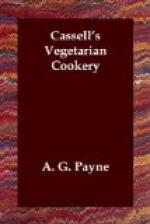MACARONI, TIMBALE OF—This is a somewhat expensive dish. You have first to decorate a plain mould with what is called nouilles paste, which is made by mixing half a pound of flour with five yolks of eggs. The mould is then lined with ordinary short paste, made with half a pound of flour, a quarter of a pound of butter, and one yolk of egg, mixed in the ordinary way. When the mould is lined, you have to fill it up with flour, and bake it in a moderate oven for about an hour. You then take it out, empty out the flour and brush it well out with an ordinary brush and dry the mould in a very slack oven. The mould is then filled with some macaroni that has been boiled tender in milk and flavoured with vanilla and sugar and Parmesan cheese. The macaroni must be so managed that it absorbs the moisture. The mould is filled, made hot, and then turned out. It is customary to shake some powdered sugar over the mould, and then glaze it with a red-hot salamander.
N.B.—Very few kitchens possess a proper salamander, but if you make the kitchen shovel red-hot it will be found to answer the same purpose.
MACARONI IN SCOLLOP SHELLS.—Take half a pound of macaroni, wash it, and throw it into boiling water. Take the macaroni out, drain it, and throw it into cold water. Then take it out and cut it into pieces not more than half an inch in length. Take about a quarter of a pound of butter, melt it in a stew-pan, and add about a cupful of milk, or still better, cream. Stir it and dredge in enough flour to make it thick, or still better, thicken it with a little white roux; now add some pepper and salt, about a quarter of a grated nutmeg, two or three spoonfuls of grated Parmesan cheese; add the cut-up macaroni and stir the whole well up over the fire together and fill the scollop shells with the mixture, and throw some grated cheese over the top. Bake the scollops in the oven till the cheese begins to brown; then pour a little oiled butter over the top of the cheese. If made with cream this dish is somewhat rich, but forms an admirable meal eaten with plenty of bread.
MACARONI NUDELS.—The word nudel is probably derived from French nouilles paste. It is made in a similar manner, or nearly so. French cooks use only yolk of egg and flour. English cooks use beaten-up eggs, and sometimes even reserve the yolks for other purposes and make the paste with white of egg. In any case, the yolks, the whole eggs, or the white without the yolks, must be well beaten up and then mixed in with the flour with the fingers till it makes a stiff paste. This paste or dough is then rolled out with a straight rolling pin—(not an English one)—till it is as thin as a wafer. The board must be well floured or it will stick. A marble slab is best, and if you are at a loss for a rolling-pin try an empty black bottle. It is very important to roll the pastry thin, and it has been well observed that the best test of thinness is to be able to read a book




